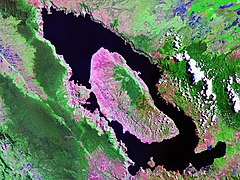
Back نظرية كارثة توبا Arabic Вядомыя вывяржэнні вулкана Тоба Byelorussian তোবা বিপর্যয় তত্ত্ব Bengali/Bangla Teoria de la catàstrofe de Toba Catalan Tobská katastrofa Czech Toba-Katastrophentheorie German Teoría de la catástrofe de Toba Spanish Tobaren katastrofearen teoria Basque نظریه فوران آتشفشان توبا Persian Théorie de la catastrophe de Toba French
The Toba eruption (sometimes called the Toba supereruption or the Youngest Toba eruption) was a supervolcanic eruption that occurred about 74,000 years ago during the Late Pleistocene[1] at the site of present-day Lake Toba in Sumatra, Indonesia. It was the last in a series of at least four caldera-forming eruptions at this location, with the earlier known caldera having formed around 1.2 million years ago.[2] This last eruption had an estimated VEI of 8, making it the largest-known explosive volcanic eruption in the Quaternary, and one of the largest known explosive eruptions in the Earth's history.
| Youngest Toba eruption | |
|---|---|
 Artist's impression of early stages of eruption from about 42 km (26 mi) above northern Sumatra | |
| Volcano | Toba Caldera Complex |
| Date | c. 74,000 years BP |
| Location | Sumatra, Indonesia 2°41′04″N 98°52′32″E / 2.6845°N 98.8756°E |
| VEI | 8 |
| Impact | Covered the Indian subcontinent in 5 cm (2.0 in) of ash,[3] volcanic winter may have caused a severe human population bottleneck |
| Deaths | (Potentially) almost all of humanity, leaving around 3,000–10,000 humans left on the planet |
 Lake Toba is the resulting crater lake | |
- ^ "Surprisingly, Humanity Survived the Super-volcano 74,000 Years Ago". Haaretz.
- ^ Stratigraphy of the Toba Tuffs and the evolution of the Toba Caldera Complex, Sumatra, Indonesia
- ^ Petraglia, Michael D.; Ditchfield, Peter; Jones, Sacha; Korisettar, Ravi; Pal, J.N. (2012). "The Toba volcanic super-eruption, environmental change, and hominin occupation history in India over the last 140,000 years". Quaternary International. 258: 119–134. doi:10.1016/j.quaint.2011.07.042. ISSN 1040-6182.
© MMXXIII Rich X Search. We shall prevail. All rights reserved. Rich X Search